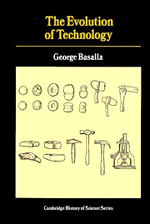Book contents
- Frontmatter
- Contents
- Preface
- I Diversity, Necessity, and Evolution
- II Continuity and Discontinuity
- III Novelty (1): Psychological and Intellectual Factors
- IV Novelty (2): Socioeconomic and Cultural Factors
- V Selection (1): Economic and Military Factors
- VI Selection (2): Social and Cultural Factors
- VII Conclusion: Evolution and Progress
- Bibliography
- Sources of Quotations
- Index
II - Continuity and Discontinuity
Published online by Cambridge University Press: 05 August 2014
- Frontmatter
- Contents
- Preface
- I Diversity, Necessity, and Evolution
- II Continuity and Discontinuity
- III Novelty (1): Psychological and Intellectual Factors
- IV Novelty (2): Socioeconomic and Cultural Factors
- V Selection (1): Economic and Military Factors
- VI Selection (2): Social and Cultural Factors
- VII Conclusion: Evolution and Progress
- Bibliography
- Sources of Quotations
- Index
Summary
Introduction
A large segment of the modem public believes that technological change is discontinuous and depends on the heroic labors of individual geniuses, such as Eli Whitney, Thomas A. Edison, Henry Ford, and Wilbur and Orville Wright, who single-handedly invent the unique machines and devices that constitute modern technology. According to this view inventions are the products of superior persons who owe little or nothing to the past.
The smaller scholarly community that concerns itself with issues in the history of technology and science rejects this explanation as simplistic because it reduces complex technological developments to a series of great inventions that precipitately burst upon the scene. However, some historians have offered more sophisticated formulations of the discontinuous explanation that do not rely upon the contributions of heroic inventors. Such theorists take their cue from the supposed revolutionary nature of scientific change.
Science, Technology, and Revolution
Recent scholarship in the history and philosophy of science has tended to favor the discrete character of scientific change. This outlook derives ultimately from the study of the emergence of modern science in the sixteenth and seventeenth centuries. Since the French Revolution, the work of Copernicus, Galileo, Kepler, and Newton has been described by the term revolution, a political metaphor that implies a violent break with the past and the establishment of a new order.
The political metaphor was applied not only to the arrival of a new way of studying nature but also to any substantial change within a science.
- Type
- Chapter
- Information
- The Evolution of Technology , pp. 26 - 63Publisher: Cambridge University PressPrint publication year: 1989



